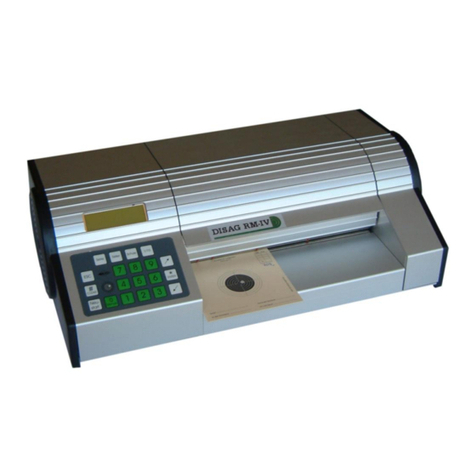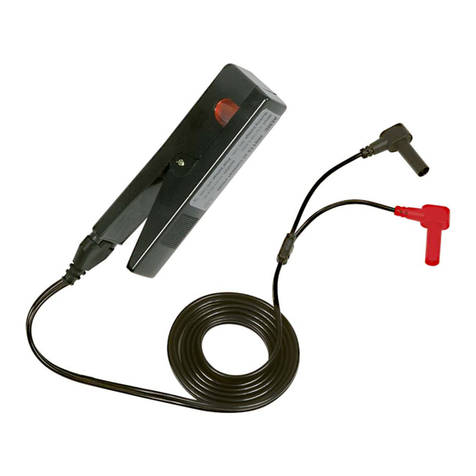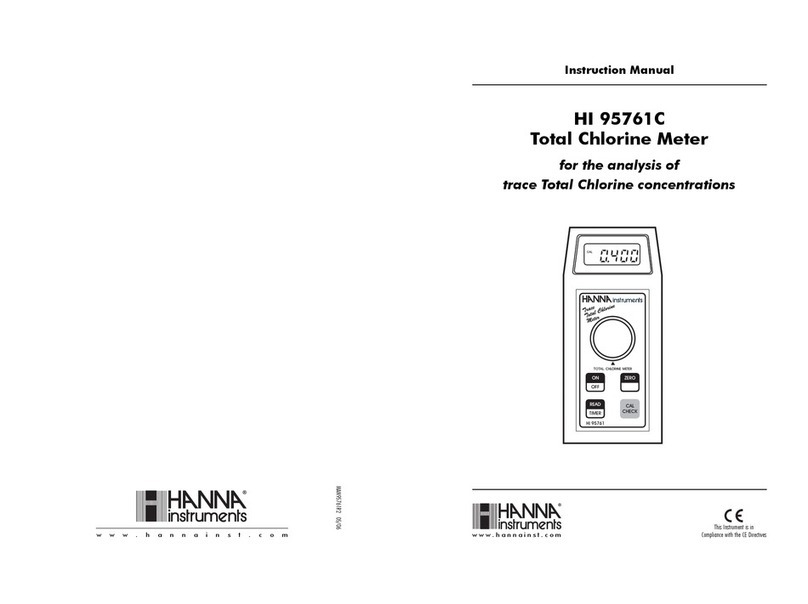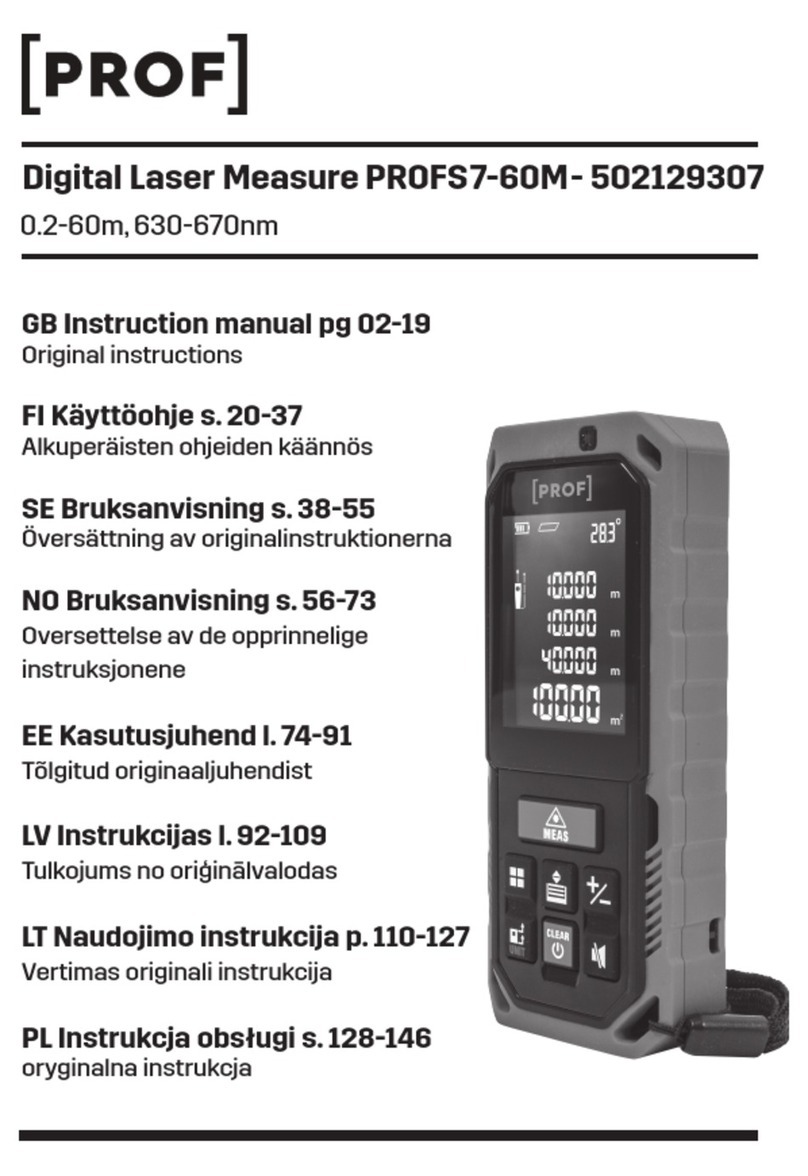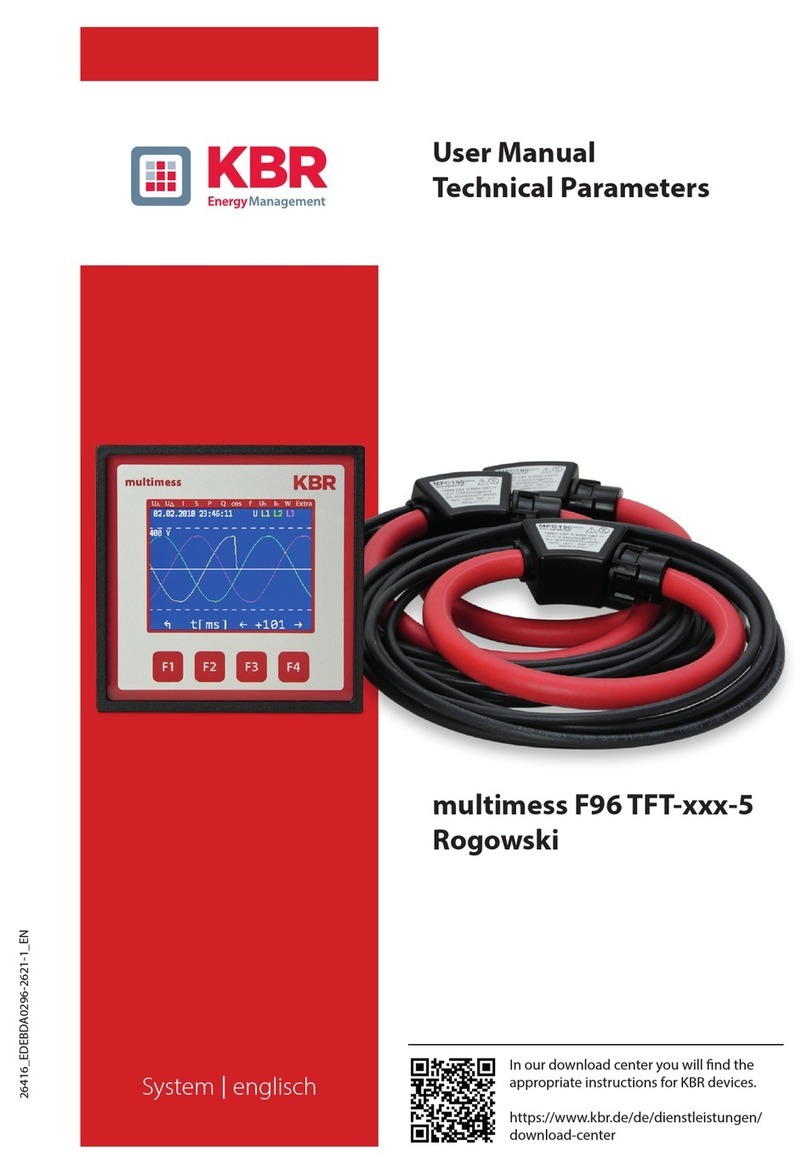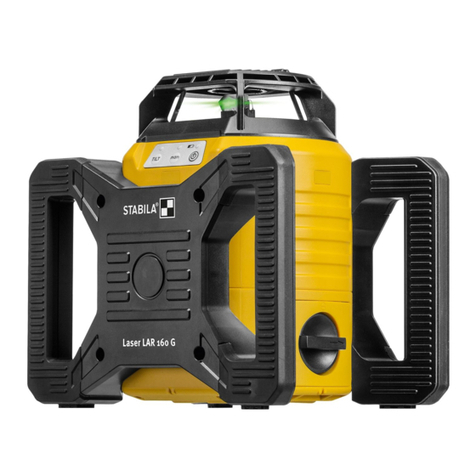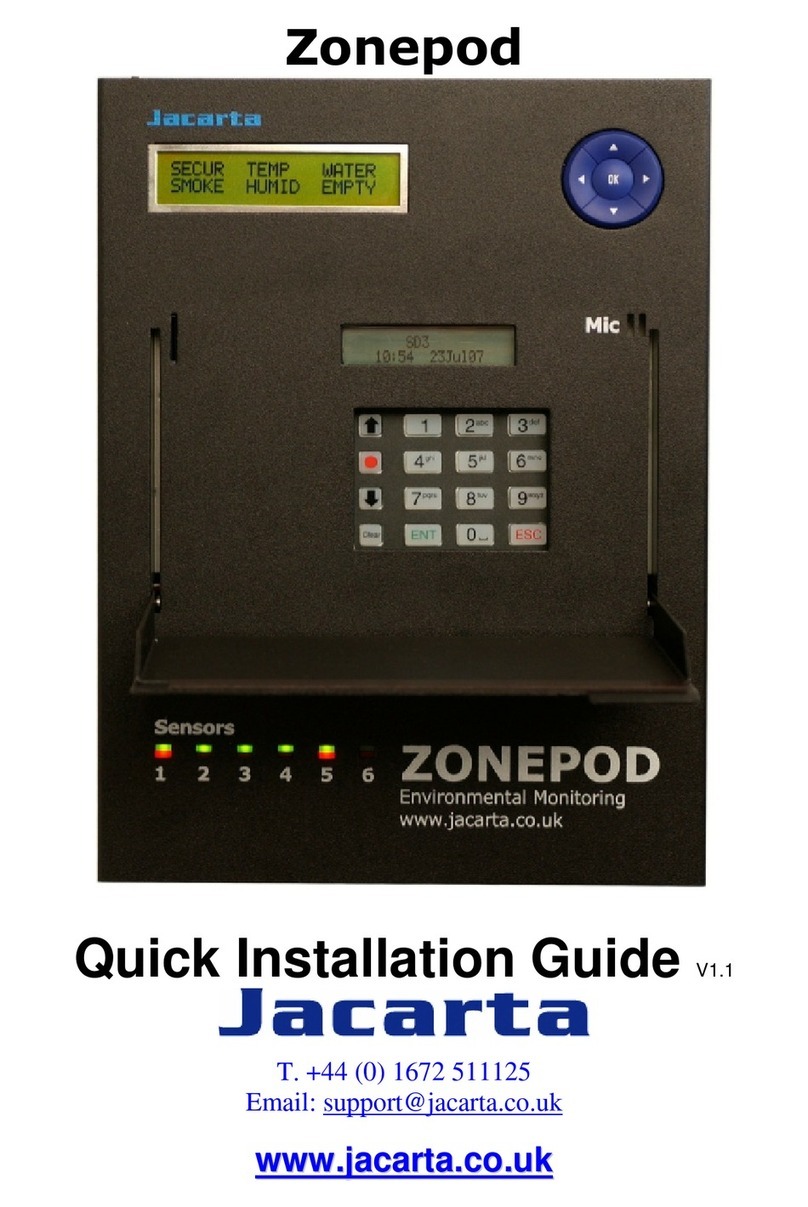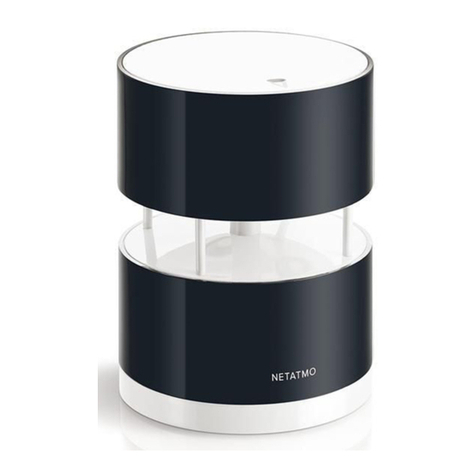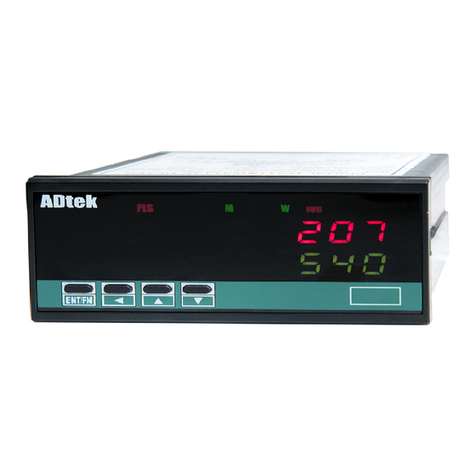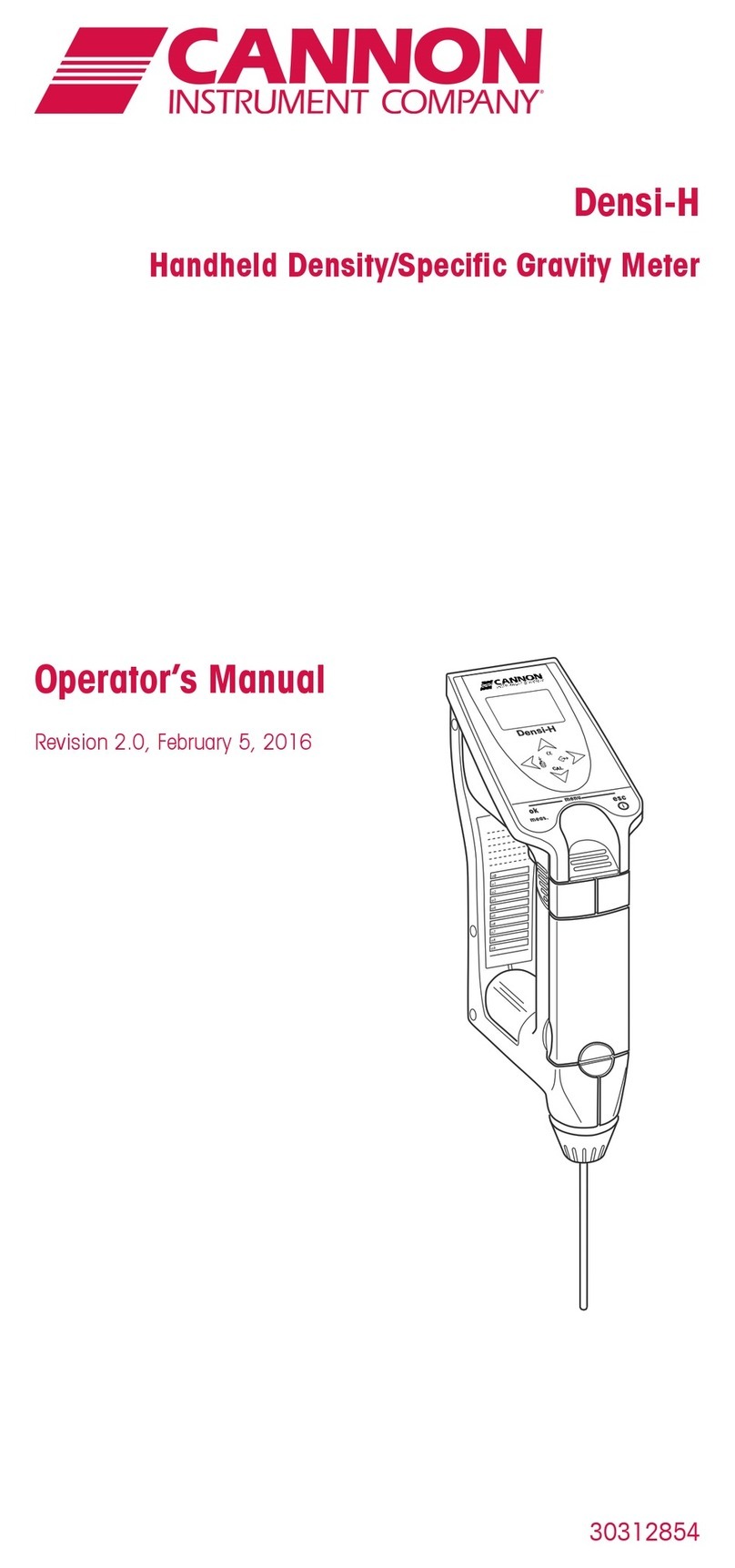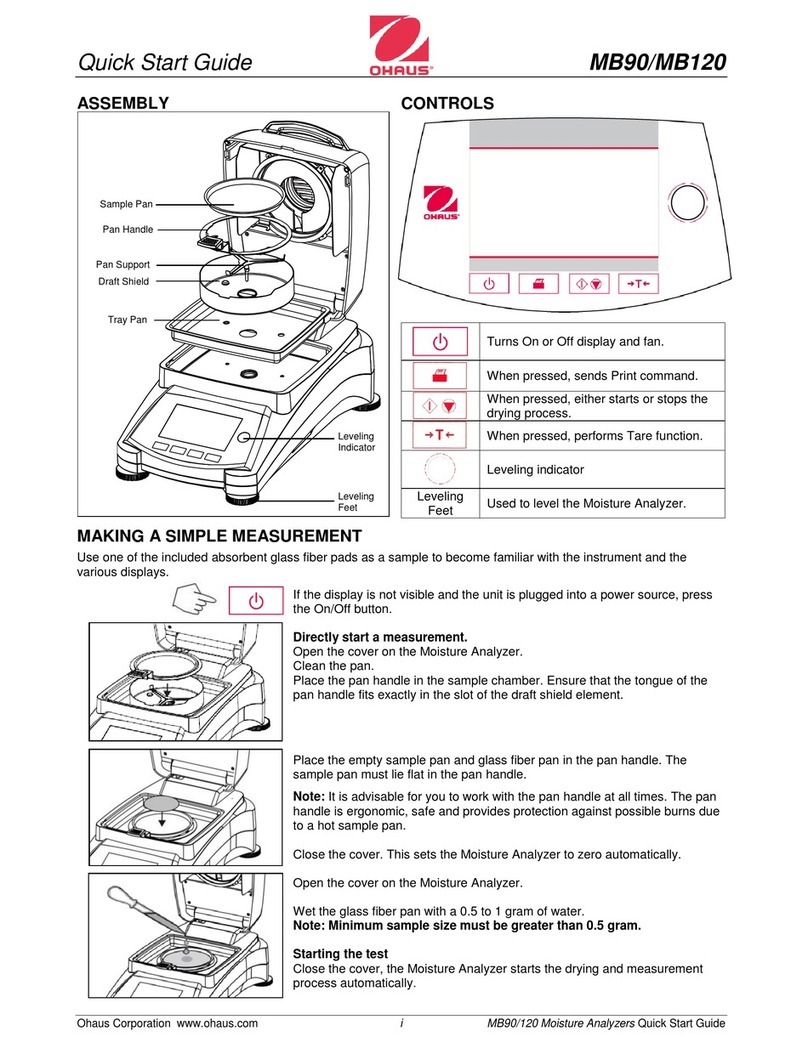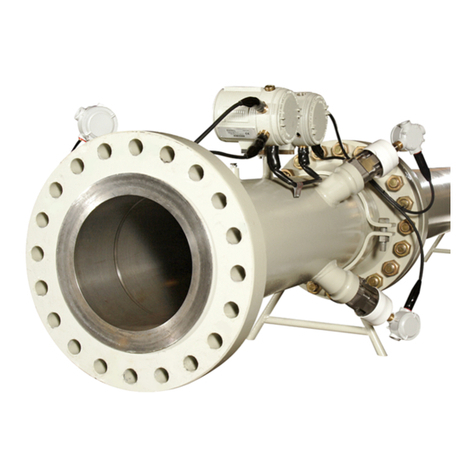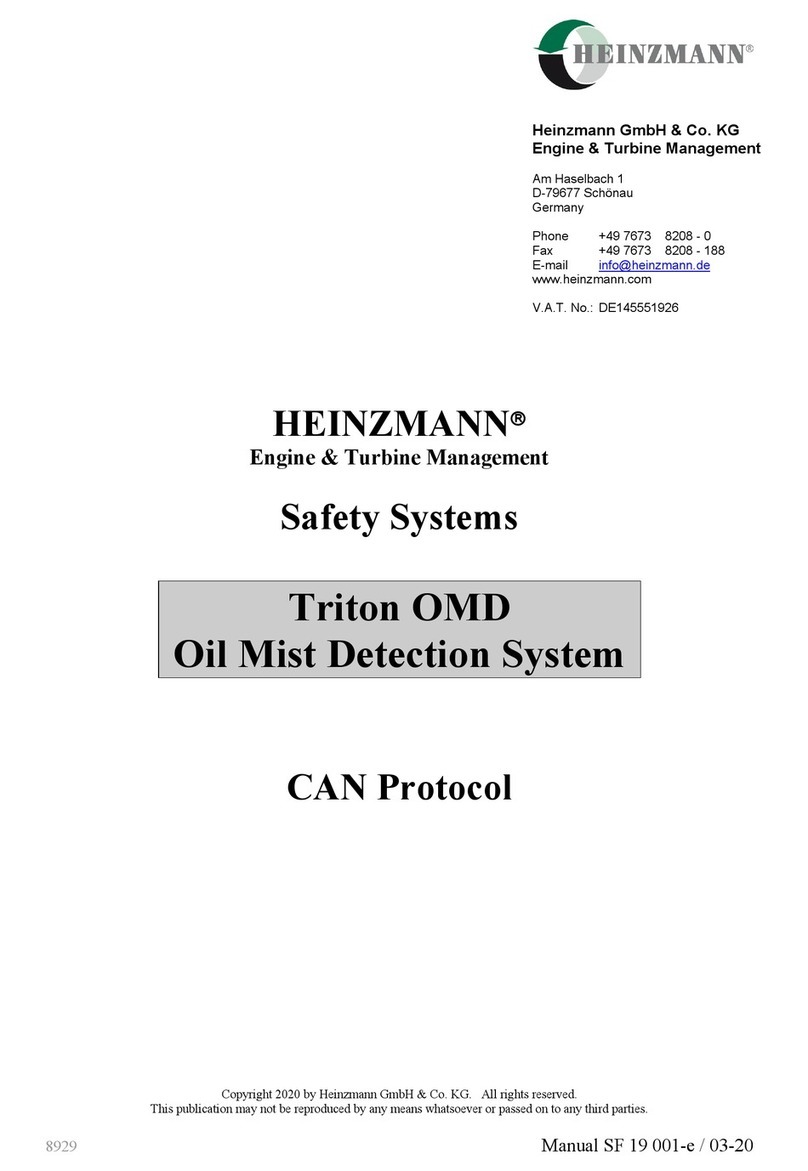Promega PowerPlex ESI 17 Fast System User manual

TECHNICAL MANUAL
PowerPlex®ESI 17 Fast System
for Use on the
Applied Biosystems®
Genetic Analyzers
Instructions for Use of Products
DC1720 and DC1721
Revised 10/23
TMD041

PowerPlex®ESI 17 Fast System for Use on
the Applied Biosystems®Genetic Analyzers
All technical literature is available at: www.promega.com/protocols/
Visit the web site to verify that you are using the most current version of this Technical Manual.
Promega Corporation · 2800 Woods Hollow Road · Madison, WI 53711-5399 USA · Toll Free in USA 800-356-9526 · 608-274-4330 · Fax 608-277-2516 1
www.promega.com TMD041 · Revised 10/23
1. Description............................................................................................................................................3
2. Product Components and Storage Conditions..............................................................................................4
3. Before You Begin....................................................................................................................................5
3.A. Precautions...................................................................................................................................5
3.B. Spectral Calibration........................................................................................................................6
4. ProtocolsforDNAAmplicationUsingthePowerPlex®ESI 17 Fast System......................................................6
4.A. AmplicationofExtractedDNAina25µlReactionVolume....................................................................7
4.A. AmplicationofExtractedDNAina25µlReactionVolume....................................................................8
4.B. DirectAmplicationofDNAfromStorageCardPunchesina25µlReactionVolume................................ 10
4.C. DirectAmplicationofDNAfromSwabsina25µlReactionVolume ..................................................... 14
5. Instrument Setup and Sample Preparation ................................................................................................ 17
5.A. DetectionofAmpliedFragmentsUsingtheAppliedBiosystems®3500or3500xLGeneticAnalyzer ......... 17
5.B. DetectionofAmpliedFragmentsUsingtheAppliedBiosystems®3130 or 3130xl GeneticAnalyzerwith
DataCollectionSoftware,Version3.0or4.0..................................................................................... 29
6. Data Analysis ....................................................................................................................................... 32
6.A. ImportingPowerPlex®ESIFastPanels,BinsandStutterTextFilesintoGeneMapper®ID-XSoftware ......... 32
6.B. ImportingtheWENILS500ESSSizeStandardintoGeneMapper®ID-XSoftware .................................... 33
6.C. CreatingaSizeStandardwithGeneMapper®ID-XSoftware................................................................. 33
6.D. CreatingaCaseworkAnalysisMethodwithGeneMapper®ID-XSoftware............................................... 35
6.E. CreatingaDatabasingorPaternityAnalysisMethodwithGeneMapper®ID-XSoftware............................ 40
6.F. ImportingPowerPlex®ESIFastPanelsandBinsTextFilesintoGeneMapper®IDSoftware,Version3.2...... 43
6.G. ImportingtheWENILS500ESSSizeStandardintoGeneMapper®IDSoftware,Version3.2...................... 44
6.H. CreatingaSizeStandardwithGeneMapper®IDSoftware,Version3.2................................................... 45
6.I. CreatingaCaseworkAnalysisMethodwithGeneMapper®IDSoftware,Version3.2 ................................ 47
6.J. CreatingaDatabasingorPaternityAnalysisMethodwithGeneMapper®ID Software,Version3.2.............. 51
6.K. Controls ..................................................................................................................................... 54
6.L. Results....................................................................................................................................... 54

2Promega Corporation · 2800 Woods Hollow Road · Madison, WI 53711-5399 USA · Toll Free in USA 800-356-9526 · 608-274-4330 · Fax 608-277-2516
TMD041 · Revised 10/23 www.promega.com
7. Troubleshooting ................................................................................................................................... 58
7.A. AmplicationandFragmentDetection ............................................................................................. 58
7.B. AmplicationofExtractedDNA ...................................................................................................... 61
7.C. DirectAmplicationofDNAfromStorageCardPunches..................................................................... 63
7.D. DirectAmplicationofDNAfromSwabs .......................................................................................... 67
7.E. GeneMapper®ID-XSoftware .......................................................................................................... 70
7.F. GeneMapper®IDSoftware ............................................................................................................. 72
8. References .......................................................................................................................................... 76
9. Appendix............................................................................................................................................. 78
9.A. AdvantagesofUsingtheLociinthePowerPlex®ESI 17 Fast System .................................................... 78
9.B. TheWENInternalLaneStandard500ESS......................................................................................... 82
9.C. DirectAmplicationofDNAfromStorageCardPunchesina12.5µlReactionVolume ............................. 82
9.D. DirectAmplicationofDNAfromSwabsina12.5µlReactionVolume................................................... 87
9.E. Composition of Buffers and Solutions ............................................................................................. 90
9.F. RelatedProducts.......................................................................................................................... 91
9.G. SummaryofChanges.................................................................................................................... 91

Promega Corporation · 2800 Woods Hollow Road · Madison, WI 53711-5399 USA · Toll Free in USA 800-356-9526 · 608-274-4330 · Fax 608-277-2516 3
www.promega.com TMD041 · Revised 10/23
1. Description
STR (short tandem repeat) loci consist of short, repetitive sequence elements 3–7 base pairs in length (1–4). These
repeats are well distributed throughout the human genome and are a rich source of highly polymorphic markers,
which may be detected using the polymerase chain reaction (5–9). Alleles of STR loci are differentiated by the
number of copies of the repeat sequence contained within the amplied region and are distinguished from one
another using uorescence detection following electrophoretic separation.
The PowerPlex®ESI 17 Fast System(a,b) is used for human identication applications including forensic analysis,
relationship testing and research use. This system allows co-amplication and four-color uorescent detection of
seventeen loci (sixteen STR loci and Amelogenin), including D22S1045, D2S1338, D19S433, D3S1358, Amelogenin,
D2S441, D10S1248, D1S1656, D18S51, D16S539, D12S391, D21S11, vWA, TH01, SE33, FGA and D8S1179.
The PowerPlex®ESI 17 Fast System is designed with six of the original seven European Standard Set (ESS) loci
(D3S1358, D18S51, TH01, vWA, D8S1179 and the more common FGA alleles) along with D16S539 and D19S433 as
smaller amplicons (<250bp), while the loci recommended by the European Network of Forensic Science Institutes
(ENFSI) and European DNA Proling Group (EDNAP) (D1S1656, D2S441, D10S1248, D12S391 and D22S1045) are
present as larger amplicons. A complementary system, the PowerPlex® ESX 17 Fast System, amplies the same
seventeen loci present in the PowerPlex®ESI 17 Fast System but with the new ENFSI/EDNAP loci designed as
mini-STRs (<125bp; D2S441, D10S1248 and D22S1045) or midi-STRs (125–185bp; D1S1656 and D12S391).
Therefore, these two STR systems can be used to complement each other when analyzing degraded or challenging
samples to maximize recovery of allelic information from as many loci as possible and allow conrmation of results
obtained with the other system.
The PowerPlex®ESI 17 Fast System and all system components are manufactured in accordance with ISO
18385:2016. All necessary materials are provided to amplify STR regions of human genomic DNA, including a
hot-start thermostable DNA polymerase, which is a component of the PowerPlex®ESI/ESX Fast 5X Master Mix.
This manual contains a protocol for use of the PowerPlex®ESI 17 Fast System with the GeneAmp®PCR System
9700, Veriti®96-Well Thermal Cycler and ProFlex® PCR System in addition to protocols to separate amplied
products and detect separated material on the Applied Biosystems®3130, 3130xl, 3500 and 3500xL Genetic
Analyzers. Protocols to operate the uorescence-detection instruments should be obtained from the instrument
manufacturer. Amplication and detection instrumentation may vary. You may need to optimize protocols including
amount of template DNA, cycle number, injection conditions and loading volume for your laboratory instrumentation.
In-house validation should be performed.
Information about other Promega uorescent STR systems is available upon request from Promega or online at:
www.promega.com

4Promega Corporation · 2800 Woods Hollow Road · Madison, WI 53711-5399 USA · Toll Free in USA 800-356-9526 · 608-274-4330 · Fax 608-277-2516
TMD041 · Revised 10/23 www.promega.com
2. Product Components and Storage Conditions
PRODUCT SIZE CAT.#
PowerPlex®ESI 17 Fast System 100 reactions DC1721
Not For Medical Diagnostic Use. This system contains sufcient reagents for 100 reactions of 25µl each. Includes:
Pre-amplicationComponentsBox
•500µl PowerPlex®ESI/ESX Fast 5X Master Mix
•250µl PowerPlex®ESI 17 Fast 10X Primer Pair Mix
• 25µl 2800M Control DNA, 10ng/µl
• 5×1,250µl Water,AmplicationGrade
Post-amplicationComponentsBox
•50µl PowerPlex®ESI17FastAllelicLadderMix
• 200µl WENInternalLaneStandard500ESS
PRODUCT SIZE CAT.#
PowerPlex®ESI 17 Fast System 400 reactions DC1720
Not For Medical Diagnostic Use. This system contains sufcient reagents for 400reactions of 25µl each. Includes:
Pre-amplicationComponentsBox
• 4 × 500µl PowerPlex®ESI/ESX Fast 5X Master Mix
• 4 × 250µl PowerPlex®ESI 17 Fast 10X Primer Pair Mix
• 25µl 2800M Control DNA, 10ng/µl
•10×1,250µl Water,AmplicationGrade
Post-amplicationComponentsBox
• 4 × 50µl PowerPlex®ESI17FastAllelicLadderMix
• 2×200µl WENInternalLaneStandard500ESS
The PowerPlex®ESI 17 Fast Allelic Ladder Mix is provided in a separate, sealed bag for shipping. This component
should be moved to the post-amplication box after opening. The Water, Amplication Grade, is provided in a
separate, sealed bag for shipping. This component should be moved to the pre-amplication box after opening.
Storage Conditions: Upon receipt, store all components at –30°C to –10°C in a nonfrost-free freezer. Make sure that
the 2800M Control DNA is stored at +2°C to +10°C for atleast24hours before use; do not refreeze. After the rst
use, store the WEN Internal Lane Standard (WEN ILS) 500 ESS at +2°C to +10°C, protected from light; do not refreeze.
The PowerPlex®ESI 17 Fast 10X Primer Pair Mix, PowerPlex®ESI 17 Fast Allelic Ladder Mix and WEN ILS 500 ESS
are light-sensitive and must be stored in the dark. We strongly recommend that pre-amplication and post-ampli-
cation reagents be stored and used separately with different pipettes, tube racks, etc.
Optional: The PowerPlex®ESI 17 Fast System components may be stored for up to 1 year at +2°C to +10°C without
loss of activity.
!

Promega Corporation · 2800 Woods Hollow Road · Madison, WI 53711-5399 USA · Toll Free in USA 800-356-9526 · 608-274-4330 · Fax 608-277-2516 5
www.promega.com TMD041 · Revised 10/23
Available Separately
PRODUCT SIZE CAT.#
PunchSolution™ Kit 100 preps DC9271
SwabSolution™ Kit 100 preps DC8271
5X AmpSolution™ Reagent 500µl DM1231
The PunchSolution™ Kit is required to process nonlytic storage card punches prior to direct amplication. The
SwabSolution™ Kit is required to process swabs prior to direct amplication. The 5X AmpSolution™ Reagent is
required for direct amplication of DNA from storage card punches and swab extracts. Both the PunchSolution™ Kit
and SwabSolution™ Kit contain the 5X AmpSolution™ Reagent.
The proper panels, bins and stutter text les and size standard .xml les for use with GeneMapper®ID and ID-X
software can be downloaded at: www.promega.com/resources/software-rmware/str-analysis/genemapper-id-
software-panels-and-bin-sets/
Matrix standards are required for initial setup of the color separation matrix. Matrix standards are provided
separately and are available for the Applied Biosystems®3130, 3130xl, 3500 and 3500xL Genetic Analyzers
(PowerPlex® 5C Matrix Standard, Cat.# DG4850).
3. BeforeYouBegin
3.A. Precautions
The application of PCR-based typing for forensic or paternity casework requires validation studies and quality-control
measures that are not contained in this manual (10,11). Guidelines for the validation process are published in the
Internal Validation Guide of Autosomal STR Systems for Forensic Laboratories (12).
The quality of puried DNA or direct-amplication samples, small changes in buffers, ionic strength, primer
concentrations, reaction volume, choice of thermal cycler and thermal cycling conditions can affect PCR success.
We suggest strict adherence to recommended procedures for amplication and uorescence detection. Additional
research and validation are required if any modications to the recommended protocols are made.
PCR-based STR analysis is subject to contamination by very small amounts of human DNA. Extreme care should be
taken to avoid cross-contamination when preparing template DNA, handling primer pairs, assembling amplication
reactions and analyzing amplication products. Reagents and materials used prior to amplication (Master Mix,
Primer Pair Mix, 2800M Control DNA and Water, Amplication Grade) are provided in a separate box and should be
stored separately from those used following amplication (Allelic Ladder Mix and Internal Lane Standard). Always
include a negative control reaction (i.e., no template) to detect reagent contamination. We highly recommend the use
of gloves and aerosol-resistant pipette tips.

6Promega Corporation · 2800 Woods Hollow Road · Madison, WI 53711-5399 USA · Toll Free in USA 800-356-9526 · 608-274-4330 · Fax 608-277-2516
TMD041 · Revised 10/23 www.promega.com
3.A. Precautions (continued)
Some reagents used in the analysis of STR products are potentially hazardous and should be handled accordingly.
Formamide is an irritant and a teratogen; avoid inhalation and contact with skin. Read the warning label, and take
appropriate precautions when handling this substance. Always wear gloves and safety glasses when working with
formamide.
3.B. Spectral Calibration
Proper spectral calibration is critical to evaluate multicolor systems with the Applied Biosystems®3130, 3130xl,
3500 and 3500xL Genetic Analyzers. A matrix must be generated for each individual instrument.
The PowerPlex®5C Matrix Standard (Cat.# DG4850) is required for spectral calibration on the Applied Biosystems®
3130, 3130xl, 3500 and 3500xL Genetic Analyzers.
For protocols and additional information about spectral calibration, see the PowerPlex®5C Matrix Standard Technical
Manual #TMD049. This manual is available online at: www.promega.com/protocols/
4. ProtocolsforDNAAmplicationUsingthePowerPlex®ESI 17 Fast System
The PowerPlex® ESI 17 Fast System was developed for amplication of extracted DNA and direct-amplication
samples. Slight protocol variations are recommended for optimal performance with each template source. Protocols
for amplication in a 25µl reaction volume using extracted DNA (Section 4.A), lytic and nonlytic storage card
punches (Section4.B) and swabs (Section 4.C) are included in the following amplication sections. Protocols for
amplication in a 12.5µl reaction volume using lytic and nonlytic storage card punches and swabs are included in
Sections 9.C and 9.D, respectively.
The PowerPlex®ESI 17 Fast System is compatible with the GeneAmp®PCR System 9700 thermal cycler with a
gold-plated silver or silver sample block, the Veriti®96-Well Thermal Cycler and the ProFlex®PCR System.
Note: It may be possible to use thermal cyclers other than those listed in this technical manual. Use of thermal
cyclers not listed here may require optimization of cycling conditions and validation in your laboratory. Use of
thermal cyclers with an aluminum block is not recommended with the PowerPlex®ESI 17 Fast System.
The use of gloves and aerosol-resistant pipette tips is highly recommended to prevent cross-contamination. Keep all
pre-amplication and post-amplication reagents in separate rooms. Prepare amplication reactions in a room
dedicated for reaction setup. Use equipment and supplies dedicated for amplication setup.
Meticulous care must be taken to ensure successful amplication. A guide to amplication troubleshooting is
provided in Section 7.
!

Promega Corporation · 2800 Woods Hollow Road · Madison, WI 53711-5399 USA · Toll Free in USA 800-356-9526 · 608-274-4330 · Fax 608-277-2516 7
www.promega.com TMD041 · Revised 10/23
4.A. AmplicationofExtractedDNAina25µlReactionVolume
The PowerPlex®ESI 17 Fast System is optimized and balanced for 0.5ng of DNA template. The amount of DNA
template used in your laboratory should be based on the results of your internal validation and may be different.
Testing at Promega shows that 30 cycles works well for 0.5ng of puried DNA templates. Developmental validation
of the system showed routine generation of full proles using 30 cycles of amplication with lower amounts of DNA
template down to 62.5pg. Partial proles were typically observed for DNA template amounts of 32pg and below (13).
In-house optimization and validation should be performed to establish the performance of the system in your
laboratory (12).
MaterialstoBeSuppliedbytheUser
•GeneAmp®PCR System 9700 with a gold-plated silver or silver sample block, Veriti®96-Well Thermal Cycler or
ProFlex®PCR System (Applied Biosystems)
• centrifuge compatible with 96-well plates or reaction tubes
•MicroAmp®optical 96-well reaction plates or 0.2ml MicroAmp®reaction tubes (Applied Biosystems)
• aerosol-resistant pipette tips
AmplicationSetup
1. Thaw the PowerPlex®ESI/ESX Fast 5X Master Mix, PowerPlex®ESI 17 Fast 10X Primer Pair Mix and Water,
Amplication Grade, completely.
Note: Centrifuge tubes briey to bring contents to the bottom, and then vortex reagents for 15 seconds before
each use. Do not centrifuge the 10X Primer Pair Mix or 5X Master Mix after vortexing, as this may cause the
reagents to be concentrated at the bottom of the tube.
2. Determine the number of reactions to be set up. This should include positive and negative control reactions.
Add 1 or 2 reactions to this number to compensate for pipetting error. While this approach does consume a
small amount of each reagent, it ensures that you will have enough PCR amplication mix for all samples. It
also ensures that each reaction contains the same PCR amplication mix.
3. Use a clean plate for reaction assembly, and label it appropriately. Alternatively, determine the number of
clean, 0.2ml reaction tubes required, and label them appropriately.

8Promega Corporation · 2800 Woods Hollow Road · Madison, WI 53711-5399 USA · Toll Free in USA 800-356-9526 · 608-274-4330 · Fax 608-277-2516
TMD041 · Revised 10/23 www.promega.com
4.A. AmplicationofExtractedDNAina25µlReactionVolume
4. Add the nal volume of each reagent listed in Table1 to a clean tube.
Table1.PCRAmplicationMixforAmplicationofExtractedDNA.
PCRAmplicationMixComponent1
Volume
PerReaction ×Number of
Reactions =Final
Volume
Water, Amplication Grade
to a nal volume
of 25.0µl × =
PowerPlex®ESI/ESX Fast 5X Master Mix 5.0µl × =
PowerPlex®ESI 17 Fast 10X Primer Pair Mix 2.5µl × =
template DNA (0.5ng)2,3,4 up to 17.5µl
total reaction volume 25.0µl
1Add Water, Amplication Grade, to the tube rst, and then add PowerPlex®ESI/ESX Fast 5X Master Mix and PowerPlex®
ESI 17 Fast 10X Primer Pair Mix. The template DNA will be added at Step6.
2Store DNA templates in TE–4 buffer (10mM Tris-HCl [pH 8.0], 0.1mM EDTA) or TE–4 buffer with 20µg/ml glycogen. If the DNA
template is stored in TE buffer that is not pH 8.0 or contains a higher EDTA concentration, the volume of DNA added should
not exceed 20% of the nal reaction volume. PCR amplication efciency and quality can be greatly altered by changes in pH
(due to added Tris-HCl), available magnesium concentration (due to chelation by EDTA) or other PCR inhibitors, which may be
present at low concentrations depending on the source of the template DNA and the extraction procedure used.
3Apparent DNA concentrations can differ, depending on the DNA quantication method used (14). We strongly recommend
that you perform experiments to determine the optimal DNA amount based on your DNA quantication method and internal
validation.
4The PowerPlex®ESI 17 Fast System is optimized and balanced for 0.5ng of DNA template. The amount of DNA template
used in your laboratory should be based on the results of your internal validation and may be different.
5. Vortex the PCR amplication mix for 5–10seconds, and then pipet PCR amplication mix into each reaction
well.
Failure to vortex the PCR amplication mix sufciently can result in poor amplication or locus-to-locus
imbalance.
Note: Do not store the PCR amplication mix for a prolonged period. Add the mix to the wells of the reaction
plate as soon as the mix is prepared. Add DNA as soon as possible to each well and follow immediately by
thermal cycling.
6. Add template DNA for each sample to the respective well containing PCR amplication mix.
Note: The PowerPlex®ESI 17 Fast System is optimized and balanced for 0.5ng of DNA template. The amount
of DNA template used in your laboratory should be based on the results of your internal validation and may be
different.
!

Promega Corporation · 2800 Woods Hollow Road · Madison, WI 53711-5399 USA · Toll Free in USA 800-356-9526 · 608-274-4330 · Fax 608-277-2516 9
www.promega.com TMD041 · Revised 10/23
7. For the positive amplication control, vortex the tube of 2800M Control DNA, and then dilute an aliquot
to 0.5ng in the desired template volume. Add 0.5ng of diluted DNA to a reaction well containing PCR
amplication mix.
8. For the negative amplication control, pipet Water, Amplication Grade, or TE–4 buffer instead of template DNA
into a reaction well containing PCR amplication mix.
9. Seal or cap the plate, or close the tubes.
Optional: Briey centrifuge the plate to bring contents to the bottom of the wells and remove any air bubbles.
ThermalCycling
Amplication and detection instrumentation may vary. You may need to optimize protocols including the amount of
template DNA, cycle number, injection conditions and loading volume for your laboratory instrumentation. Testing at
Promega shows that 30cycles work well for 0.5ng of puried DNA templates. In-house validation should be
performed.
1. Place the reaction plate or tubes in the thermal cycler.
2. Select and run the recommended protocol below.
Notes:
a. When using the ProFlex®PCR System, use the 9700 Simulation Mode as the ramp speed.
b. When using the Veriti®96-Well Thermal Cycler, set the ramping rate to 100%.
c. When using the GeneAmp®PCR System 9700, the program must be run with Max Mode as the ramp
speed. This requires a gold-plated silver or silver sample block. The ramp speed is set after the thermal
cycling run is started. When the ‘Select Method Options’ screen appears, select Max for the ramp speed
and enter the reaction volume.
ThermalCyclingProtocol
96°C for 1 minute, then:
96°C for 5 seconds
60°C for 35 seconds
72°C for 5 seconds
for 30 cycles, then:
60°C for 2 minutes
4°C soak
3. After completion of the thermal cycling protocol, proceed to fragment analysis or store amplied samples at
–20°C protected from light.
Note: Long-term storage of amplied samples at 4°C or higher may produce artifacts.

10 Promega Corporation · 2800 Woods Hollow Road · Madison, WI 53711-5399 USA · Toll Free in USA 800-356-9526 · 608-274-4330 · Fax 608-277-2516
TMD041 · Revised 10/23 www.promega.com
4.B. DirectAmplicationofDNAfromStorageCardPunchesina25µlReactionVolume
MaterialstoBeSuppliedbytheUser
•GeneAmp®PCR System 9700 with a gold-plated silver or silver sample block, Veriti®96-Well Thermal Cycler or
ProFlex®PCR System (Applied Biosystems)
• centrifuge compatible with 96-well plates or reaction tubes
•MicroAmp®optical 96-well reaction plate or 0.2ml MicroAmp®reaction tubes (Applied Biosystems)
• aerosol-resistant pipette tips
• PunchSolution™ Kit (Cat.# DC9271) for nonlytic storage card punches
• 5X AmpSolution™ Reagent (Cat.# DM1231, also supplied with the PunchSolution™ Kit)
• 1.2mm Harris Micro-Punch or equivalent manual punch and cutting mat or automated punch system
This section contains a protocol for direct amplication of DNA from storage card punches in a 25µl reaction volume
using the PowerPlex®ESI 17 Fast System and GeneAmp®PCR System 9700, Veriti®96-Well Thermal Cycler or
ProFlex® PCR System. A protocol for direct amplication of DNA from storage card punches in a 12.5µl reaction
volume is provided in Section 9.C.
When using the protocol detailed below, add the number of 1.2mm storage card punches indicated below to each
25μl amplication reaction.
Note: You will need to optimize and validate the number of storage card punches per reaction in your laboratory. See
the PCR Optimization recommendations at the end of this section.
Lyticstoragecardsampletypesinclude:
• Buccal cells collected on FTA® cards with Whatman EasiCollect™ devices (one or two punches per 25µl
amplication reaction)
• Buccal cells collected with swabs transferred to FTA®or Indicating FTA® cards (one or two punches per 25µl
amplication reaction)
• Liquid blood (from collection or storage Vacutainer® tubes or nger sticks) spotted onto FTA®cards (one
punch per 25µl amplication reaction)
Nonlytic storage card sample types include:
• Buccal samples on Bode Buccal DNA Collector™ devices (one punch per 25µl amplication reaction)
• Blood and buccal samples on nonlytic storage cards (e.g., S&S 903; one punch per 25µl amplication reaction)
Pretreat nonlytic sample types with the PunchSolution™ Kit (Cat.# DC9271) to lyse samples before adding the PCR
amplication mix. For more information, see the PunchSolution™ Kit Technical Manual #TMD038. Failure to pretreat
these samples may result in incomplete proles.
Use a manual punch tool with a 1.2mm tip to manually create sample disks from a storage card. Place tip near the
center of the sample spot, and with a twisting or pressing action, cut a 1.2mm sample disk. Use the plunger to eject
the disk into the appropriate well of a reaction plate.

Promega Corporation · 2800 Woods Hollow Road · Madison, WI 53711-5399 USA · Toll Free in USA 800-356-9526 · 608-274-4330 · Fax 608-277-2516 11
www.promega.com TMD041 · Revised 10/23
Automated punchers also can be used to create sample disks. Refer to the user’s guide for your instrument for
assistance with generating 1.2mm disks, technical advice and troubleshooting information.
Note: Static may be problematic when adding a punch to a well. For lytic storage card punches, adding PCR
amplication mix to the well before adding the punch may help alleviate static problems. For nonlytic storage card
punches, adding PunchSolution™ Reagent to the well before adding the punch during pretreatment may help alleviate
static problems.
AmplicationSetup
1. Thaw the PowerPlex®ESI/ESX Fast 5X Master Mix, PowerPlex®ESI 17 Fast 10X Primer Pair Mix and Water,
Amplication Grade, completely.
Note: Centrifuge tubes briey to bring contents to the bottom, and then vortex reagents for 15 seconds before
each use. Do not centrifuge the 10X Primer Pair Mix or 5X Master Mix after vortexing, as this may cause the
reagents to be concentrated at the bottom of the tube.
2. Vortex the 5X AmpSolution™ Reagent for 10–15 seconds.
Note: The 5X AmpSolution™ Reagent should be thawed completely, mixed by vortexing and stored at +2°C to
+10°C. The reagent may be turbid after thawing or storage at +2°C to +10°C. If this occurs, warm the buffer
briey at 37°C, and then vortex until clear. Do not store reagents in the refrigerator door, where the temperature
can uctuate. Storing reagents in the refrigerator door can compromise stability.
3. Determine the number of reactions to be set up. This should include positive and negative control reactions.
Add 1 or 2 reactions to this number to compensate for pipetting error. While this approach does consume a
small amount of each reagent, it ensures that you will have enough PCR amplication mix for all samples. It
also ensures that each reaction contains the same PCR amplication mix.
4. Use a clean plate for reaction assembly, and label it appropriately. Alternatively, determine the number of
clean, 0.2ml reaction tubes required, and label them appropriately.

12 Promega Corporation · 2800 Woods Hollow Road · Madison, WI 53711-5399 USA · Toll Free in USA 800-356-9526 · 608-274-4330 · Fax 608-277-2516
TMD041 · Revised 10/23 www.promega.com
4.B. DirectAmplicationofDNAfromStorageCardPunchesina25µlReactionVolume(continued)
5. AddthenalvolumeofeachreagentlistedinTable2toacleantube.
Table2.PCRAmplicationMixforDirectAmplicationofDNAfromStorageCardPunchesina25µl
ReactionVolume.
PCRAmplicationMixComponent1
Volume
PerReaction ×Numberof
Reactions =Final
Volume
Water,AmplicationGrade 12.5µl × =
PowerPlex®ESI/ESXFast5XMasterMix 5.0µl × =
PowerPlex®ESI17Fast
10XPrimerPairMix 2.5µl × =
5XAmpSolution™Reagent 5.0µl × =
totalreactionvolume 25.0µl
1AddWater,AmplicationGrade,tothetuberst,andthenaddPowerPlex®ESI/ESXFast5XMasterMix,PowerPlex®ESI
17Fast10XPrimerPairMixand5XAmpSolution™Reagent.Forlyticstoragecardpunches,thetemplateDNAwillbe
addedatStep7.
6. VortexthePCRamplicationmixfor5–10seconds,andthenpipet25µlofPCRamplicationmixintoeach
reactionwell.
FailuretovortexthePCRamplicationmixsufcientlycanresultinpooramplicationorlocus-to-locus
imbalance.
Note:DonotstorethePCRamplicationmixforaprolongedperiod.Addthemixtothewellsofthereaction
plateassoonasthemixisprepared.Addthepunchesassoonaspossibletoeachwellandfollowimmediately
bythermalcycling.
7. Forlyticstoragecards,addoneortwo1.2mmpunchesfromacardcontainingabuccalsampleorone1.2mm
punchfromacardcontainingwholebloodtotheappropriatewellsofthereactionplate.Fornonlyticstorage
cardpunches,addthePCRamplicationmixtothePunchSolution™Reagent-treatedpunches.
Note:Italsoisacceptabletoaddthelyticstoragecardpunchrst,andthenaddthePCRamplicationmix.
8. Forthepositiveamplicationcontrol,vortexthetubeof2800MControlDNAthenadd1μl(10ng)toareaction
wellcontaining25μlofPCRamplicationmix.
Notes:
a. Donotincludeblankstoragecardpunchesinthepositivecontrolreactions.
b. Optimizationoftheamountof2800MControlDNAmayberequired,dependingonthermalcycling
conditionsandlaboratorypreferences.
!

Promega Corporation · 2800 Woods Hollow Road · Madison, WI 53711-5399 USA · Toll Free in USA 800-356-9526 · 608-274-4330 · Fax 608-277-2516 13
www.promega.com TMD041 · Revised 10/23
9. Reserve a well containing PCR amplication mix as a negative amplication control.
Note: An additional negative control with a blank punch may be performed to detect contamination from the
storage card or punch device.
10. Seal or cap the plate, or close the tubes. Briey centrifuge the plate to bring storage card punches to the
bottom of the wells and remove any air bubbles.
ThermalCycling
Amplication and detection instrumentation may vary. You will need to optimize protocols including the number of
storage card punches, cycle number, injection conditions and loading volume for your laboratory instrumentation.
Testing at Promega shows that 26cycles works well for a variety of storage card sample types. Cycle number will
need to be optimized in each laboratory for each sample type.
1. Place the reaction plate or tubes in the thermal cycler.
2. Select and run the recommended protocol below.
Notes:
a. When using the ProFlex®PCR System, use the 9700 Simulation Mode as the ramp speed.
b. When using the Veriti®96-Well Thermal Cycler, set the ramping rate to 100%.
c. When using the GeneAmp®PCR System 9700, the program must be run with Max Mode as the ramp
speed. This requires a gold-plated silver or silver sample block. The ramp speed is set after the thermal
cycling run is started. When the ‘Select Method Options’ screen appears, select Max for the ramp speed
and enter the reaction volume.
ThermalCyclingProtocol
96°C for 1 minute, then:
96°C for 5 seconds
60°C for 35 seconds
72°C for 5 seconds
for 26 cycles, then:
60°C for 2 minutes
4°C soak
3. After completion of the thermal cycling protocol, proceed to fragment analysis or store amplied samples at
–20°C protected from light.
Note: Long-term storage of amplied samples at 4°C or higher may produce artifacts.

14 Promega Corporation · 2800 Woods Hollow Road · Madison, WI 53711-5399 USA · Toll Free in USA 800-356-9526 · 608-274-4330 · Fax 608-277-2516
TMD041 · Revised 10/23 www.promega.com
4.B. DirectAmplicationofDNAfromStorageCardPunchesina25µlReactionVolume(continued)
PCROptimization
Cycle number should be optimized based on the results of an initial experiment to determine the sensitivity with your
collection method, sample types, number of punches and instrumentation.
1. Choose several samples that represent typical sample types you encounter in the laboratory. Prepare them as
you would using your normal workow.
2. Depending on your preferred protocol, place one or two 1.2mm storage card punches containing a buccal
sample or one 1.2mm storage card punch containing whole blood into each well of a reaction plate. Be sure to
pretreat nonlytic storage card samples with the PunchSolution™ Kit (Cat.# DC9271).
3. Prepare three identical reaction plates with punches from the same samples.
4. Amplify samples using the thermal cycling protocol provided above, but subject each plate to a different cycle
number (25, 26 and 27cycles).
5. Following amplication, use your laboratory’s validated separation and detection protocols to determine the
optimal cycle number for the sample type and number of storage card punches.
4.C. DirectAmplicationofDNAfromSwabsina25µlReactionVolume
MaterialstoBeSuppliedbytheUser
•GeneAmp®PCR System 9700 with a gold-plated silver or silver sample block, Veriti®96-Well Thermal Cycler or
ProFlex®PCR System (Applied Biosystems)
• centrifuge compatible with 96-well plates or reaction tubes
•MicroAmp®optical 96-well reaction plate or 0.2ml MicroAmp®reaction tubes (Applied Biosystems)
• aerosol-resistant pipette tips
• SwabSolution™ Kit (Cat.# DC8271)
This section contains a protocol for amplifying DNA from swab extracts in a 25µl reaction volume using the
PowerPlex®ESI 17 Fast System and GeneAmp®PCR System 9700, Veriti®96-Well Thermal Cycler or ProFlex®PCR
System. A protocol for direct amplication of DNA from swab extracts in a 12.5µl reaction volume is provided in
Section 9.D.
Pretreat OmniSwab™ (QIAGEN) or cotton swabs using the SwabSolution™ Kit (Cat.# DC8271) as described in the
SwabSolution™ Kit Technical Manual #TMD037 to generate a swab extract.
AmplicationSetup
1. Thaw the PowerPlex®ESI/ESX Fast 5X Master Mix, PowerPlex®ESI 17 Fast 10X Primer Pair Mix and Water,
Amplication Grade, completely.
Note: Centrifuge tubes briey to bring contents to the bottom, and then vortex reagents for 15 seconds before
each use. Do not centrifuge the 10X Primer Pair Mix or 5X Master Mix after vortexing, as this may cause the
reagents to be concentrated at the bottom of the tube.

Promega Corporation · 2800 Woods Hollow Road · Madison, WI 53711-5399 USA · Toll Free in USA 800-356-9526 · 608-274-4330 · Fax 608-277-2516 15
www.promega.com TMD041 · Revised 10/23
2. Vortex the 5X AmpSolution™ Reagent for 10–15 seconds.
Note: The 5X AmpSolution™ Reagent should be thawed completely, mixed by vortexing and stored at +2°C to
+10°C. The reagent may be turbid after thawing or storage at +2°C to +10°C. If this occurs, warm the buffer
briey at 37°C, and then vortex until clear. Do not store reagents in the refrigerator door, where the temperature
can uctuate. Storing reagents in the refrigerator door can compromise stability.
3. Determine the number of reactions to be set up. This should include positive and negative control reactions.
Add 1 or 2 reactions to this number to compensate for pipetting error. While this approach does consume a
small amount of each reagent, it ensures that you will have enough PCR amplication mix for all samples. It
also ensures that each reaction contains the same PCR amplication mix.
4. Use a clean plate for reaction assembly, and label it appropriately. Alternatively, determine the number of
clean, 0.2ml reaction tubes required, and label them appropriately.
5. Add the nal volume of each reagent listed in Table 3 to a clean tube.
Table 3. PCR Amplication Mix for Direct Amplication of DNA from Swabs in a 25µl Reaction Volume.
PCR Amplication Mix Component1
Volume
Per Reaction ×Number of
Reactions =Final
Volume
Water, Amplication Grade 10.5µl × =
PowerPlex®ESI/ESX Fast 5X Master Mix 5.0µl × =
PowerPlex® ESI 17 Fast 10X Primer Pair Mix 2.5µl × =
5X AmpSolutionTM Reagent 5.0µl × =
swab extract 2.0µl
total reaction volume 25.0µl
1Add Water, Amplication Grade, to the tube rst, and then add PowerPlex®ESI/ESX Fast 5X Master Mix, PowerPlex®ESI
17 Fast 10X Primer Pair Mix and 5X AmpSolution™ Reagent. The swab extract will be added at Step 7.
6. Vortex the PCR amplication mix for 5–10 seconds, and then pipet 23µl of PCR amplication mix into each
reaction well.
Failure to vortex the PCR amplication mix sufciently can result in poor amplication or locus-to-locus
imbalance.
Note: Do not store the PCR amplication mix for a prolonged period. Add the mix to the wells of the reaction
plate as soon as the mix is prepared. Add the swab extract as soon as possible to each well and follow
immediately by thermal cycling.
7. Pipet 2µl of swab extract for each sample into the appropriate well of the reaction plate.
8. For the positive amplication control, vortex the tube of 2800M Control DNA, and then dilute an aliquot to 5ng/μl.
Add 2μl (10ng) of the diluted 2800M Control DNA to a reaction well containing 23μl of PCR amplication mix.
Note: Optimization of the amount of 2800M Control DNA may be required depending on thermal cycling
conditions and laboratory preferences.
!

16 Promega Corporation · 2800 Woods Hollow Road · Madison, WI 53711-5399 USA · Toll Free in USA 800-356-9526 · 608-274-4330 · Fax 608-277-2516
TMD041 · Revised 10/23 www.promega.com
4.C. Direct Amplication of DNA from Swabs in a 25µl Reaction Volume (continued)
9. For the negative amplication control, pipet 2µl of Water, Amplication Grade, or TE–4 buffer instead of swab
extract into a reaction well containing PCR amplication mix.
Note: Additional negative controls can be included. Assemble a reaction containing the swab extract prepared
from a blank swab, or assemble a reaction where the SwabSolution™ Reagent is processed as a blank without
a swab.
10. Seal or cap the plate, or close the tubes.
Optional: Briey centrifuge the plate to bring contents to the bottom of the wells and remove any air bubbles.
Thermal Cycling
Amplication and detection instrumentation may vary. You will need to optimize protocols including the amount of
template DNA, cycle number, injection conditions and loading volume for your laboratory instrumentation. Testing at
Promega shows that 26cycles works well for a variety of swab sample types. Cycle number will need to be
optimized in each laboratory for each sample type.
1. Place the reaction plate or tubes in the thermal cycler.
2. Select and run the recommended protocol below.
Notes:
a. When using the ProFlex® PCR System, use the 9700 Simulation Mode as the ramp speed.
b. When using the Veriti® 96-Well Thermal Cycler, set the ramping rate to 100%.
c. When using the GeneAmp® PCR System 9700, the program must be run with Max Mode as the ramp
speed. This requires a gold-plated silver or silver sample block. The ramp speed is set after the thermal
cycling run is started. When the ‘Select Method Options’ screen appears, select Max for the ramp speed
and enter the reaction volume.
Thermal Cycling Protocol
96°C for 1 minute, then:
96°C for 5 seconds
60°C for 35 seconds
72°C for 5 seconds
for 26 cycles, then:
60°C for 2 minutes
4°C soak
3. After completion of the thermal cycling protocol, proceed to fragment analysis or store amplied samples at
–20°C protected from light.
Note: Long-term storage of amplied samples at 4°C or higher may produce artifacts.

Promega Corporation · 2800 Woods Hollow Road · Madison, WI 53711-5399 USA · Toll Free in USA 800-356-9526 · 608-274-4330 · Fax 608-277-2516 17
www.promega.com TMD041 · Revised 10/23
PCR Optimization
Cycle number should be optimized based on the results of an initial experiment to determine the sensitivity with your
collection method, sample types and instrumentation.
1. Choose several samples that represent typical sample types you encounter in the laboratory. Prepare them as
you would using your normal workow.
2. Prepare three identical reaction plates with aliquots of the same swab extracts.
3. Amplify samples using the thermal cycling protocol provided above, but subject each plate to a different cycle
number (25, 26 and 27cycles).
Note: This recommendation is for 2µl of swab extract. If a different volume of swab extract is used, additional
cycle number testing may be required.
4. Following amplication, use your laboratory’s validated separation and detection protocols to determine the
optimal cycle number for the sample type.
5. Instrument Setup and Sample Preparation
5.A. DetectionofAmpliedFragmentsUsingtheAppliedBiosystems®3500or3500xLGeneticAnalyzer
MaterialstoBeSuppliedbytheUser
• 95°C dry heating block, water bath or thermal cycler
• crushed ice, ice-water bath or freezer plate block
• centrifuge compatible with 96-well plates
• aerosol-resistant pipette tips
• 3500/3500xL capillary array, 36cm
• 96-well retainer & base set (standard) (Applied Biosystems Cat.# 4410228)
•POP-4® polymer for the Applied Biosystems®3500 or 3500xL Genetic Analyzer
• anode buffer container
• cathode buffer container
•MicroAmp® optical 96-well plate (or equivalent) and septa (Applied Biosystems)
• Hi-Di™ formamide (Applied Biosystems Cat.# 4311320)
The quality of formamide is critical. Use only the recommended formamide. Freeze formamide in aliquots at –20°C.
Multiple freeze-thaw cycles or long-term storage at 4°C may cause breakdown of formamide. Poor-quality formamide
may contain ions that compete with DNA during injection, which results in lower peak heights and reduced sensitivity.
A longer injection time may not increase the signal.
Formamide is an irritant and a teratogen; avoid inhalation and contact with skin. Read the warning label, and take
appropriate precautions when handling this substance. Always wear gloves and safety glasses when working with
formamide.
!
!

18 Promega Corporation · 2800 Woods Hollow Road · Madison, WI 53711-5399 USA · Toll Free in USA 800-356-9526 · 608-274-4330 · Fax 608-277-2516
TMD041 · Revised 10/23 www.promega.com
5.A. DetectionofAmpliedFragmentsUsingtheAppliedBiosystems®3500or3500xLGeneticAnalyzer(continued)
SamplePreparation
1. Prepare a loading cocktail by combining and mixing internal lane standard (ILS) and formamide as follows:
[(0.5μlILS)×(#samples)]+[(9.5μlformamide)×(#samples)]
Note: The volume of internal lane standard used in the loading cocktail can be adjusted to change the intensity
of the size standard peaks based on laboratory preferences.
2. Vortex for 10–15 seconds to mix.
3. Pipet10μlofformamide/internallanestandardmixintoeachwell.
4. Add1μlofampliedsample(or1μlofAllelicLadderMix)toeachwell.Coverwellswithappropriatesepta.
Notes:
a. Instrument detection limits vary; therefore, injection time, injection voltage or the amount of product
mixed with loading cocktail may need to be increased or decreased. To modify the injection time or
injection voltage in the run module, select InstrumentProtocol from the Library menu in the data
collectionsoftware.Ifpeakheightsarehigherthandesired,uselessDNAtemplateintheamplication
reactionsorreducethenumberofcyclesintheamplicationprogramtoachievethedesiredsignal
intensity.
b. Use a volume of allelic ladder that results in peak heights that are all consistently above the peak
amplitude threshold determined as part of your internal validation.
5. Centrifugeplatebrieytoremoveairbubblesfromthewells.
6. Denaturesamplesat95°Cfor3minutes,andthenimmediatelychilloncrushedice,afreezerplateblockorin
anice-waterbathfor3minutes.Denaturesamplesjustpriortoloadingtheinstrument.

Promega Corporation · 2800 Woods Hollow Road · Madison, WI 53711-5399 USA · Toll Free in USA 800-356-9526 · 608-274-4330 · Fax 608-277-2516 19
www.promega.com TMD041 · Revised 10/23
Instrument Preparation
Refer to the Applied Biosystems 3500/3500xL Genetic Analyzer User Guide for the instrument maintenance schedule
and instructions to install the capillary array, buffers and polymer pouch and perform a spatial calibration. Samples
may be analyzed as described in the Applied Biosystems 3500/3500xL Genetic Analyzer User Guide.
1. Open the 3500 Data Collection Software. The Dashboard screen will launch (Figure1). To ensure you are
viewing the most up-to-date information, press theRefresh button. Ensure that the Consumables Information
and Maintenance Notications are acceptable.
Set the oven temperature to 60°C, and then select StartPre-heat. When the Oven Temperature and Detection
Cell Temperature turn green, you can proceed with the rst injection.
Figure1.TheDashboard.
9247TA
Table of contents
Other Promega Measuring Instrument manuals
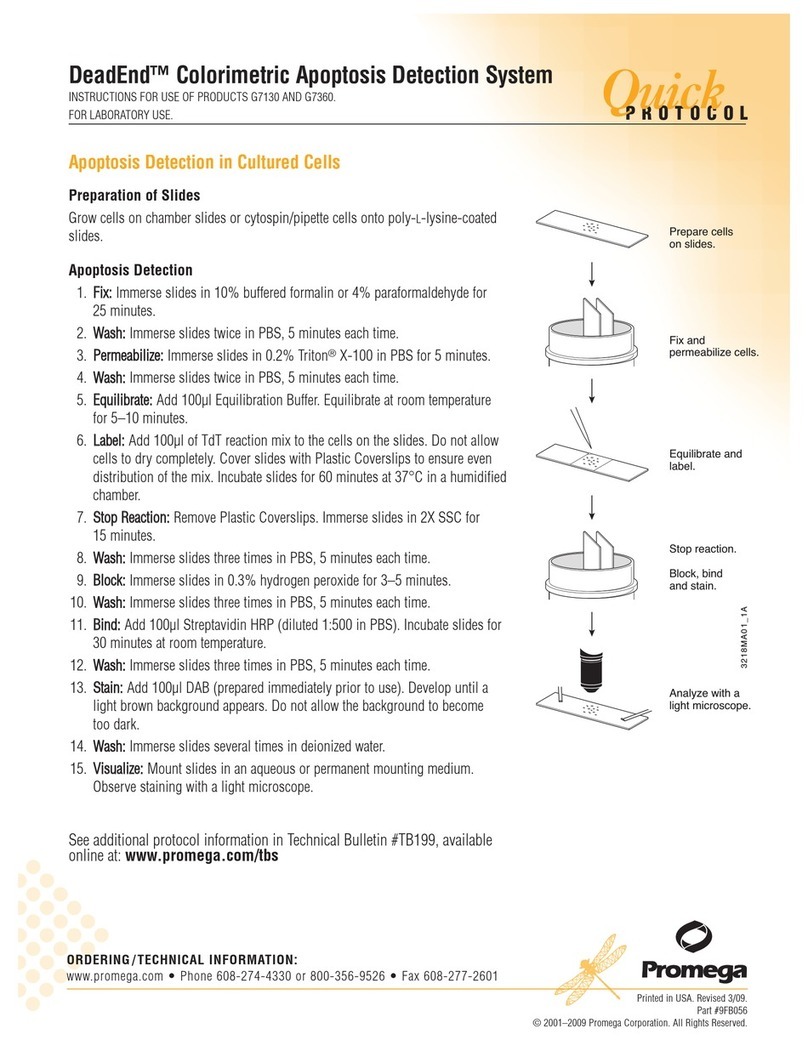
Promega
Promega DeadEnd G7360 User manual

Promega
Promega GloMax 20/20 User manual
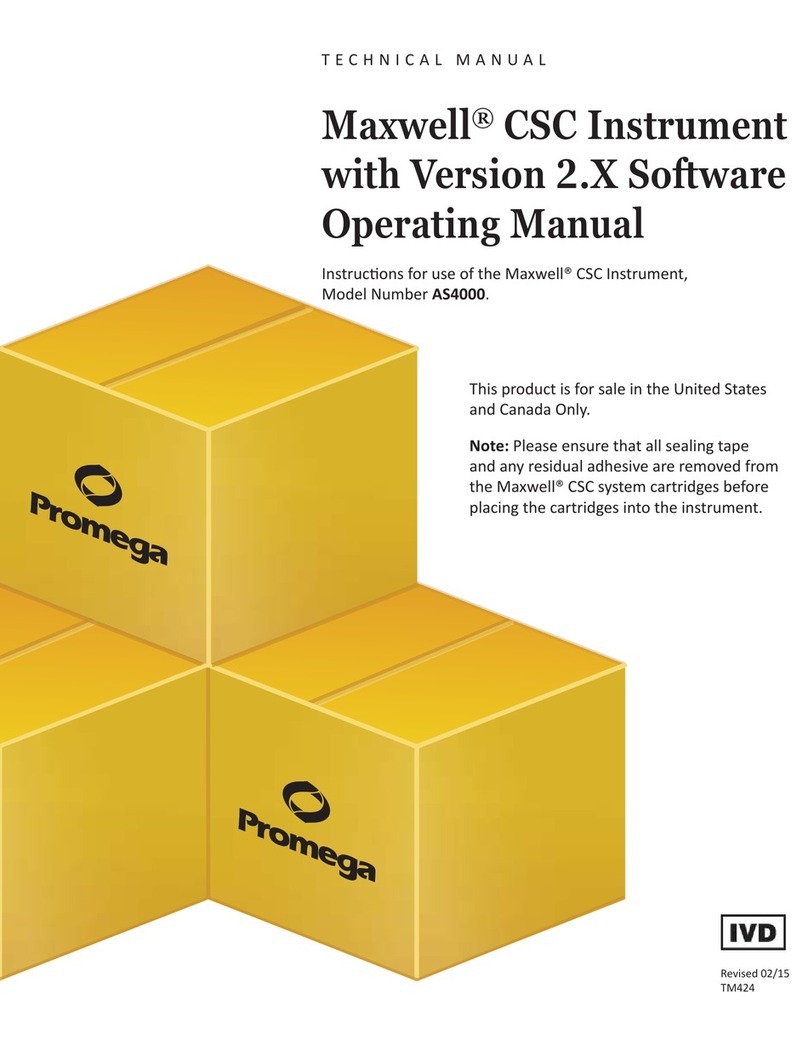
Promega
Promega Maxwell CSC Instrument User manual
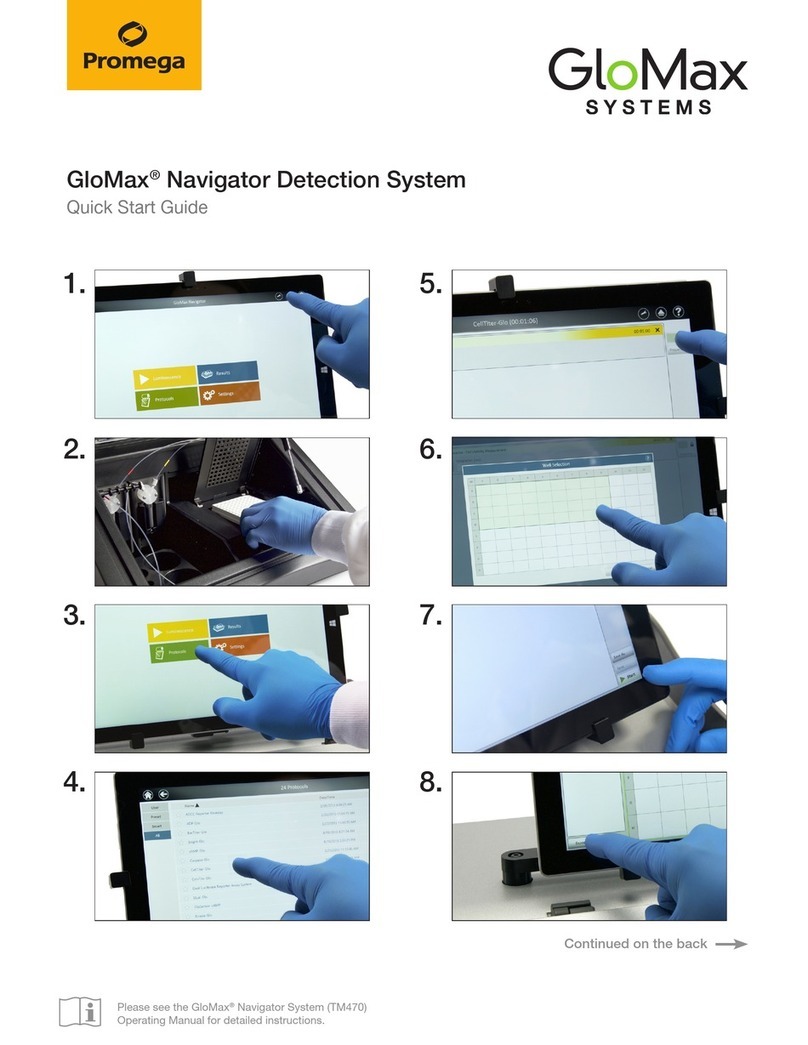
Promega
Promega GloMax Navigator Detection System User manual
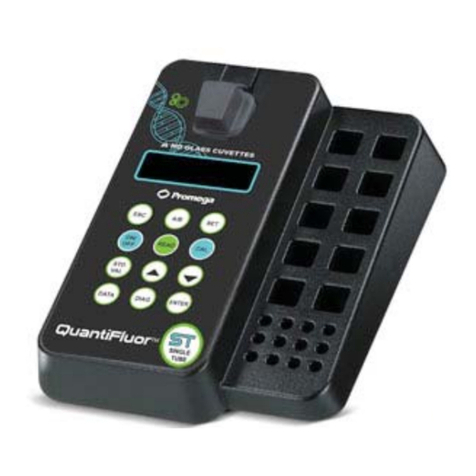
Promega
Promega QuantiFluor E6090 User manual

Promega
Promega GloMax GM3000 User manual
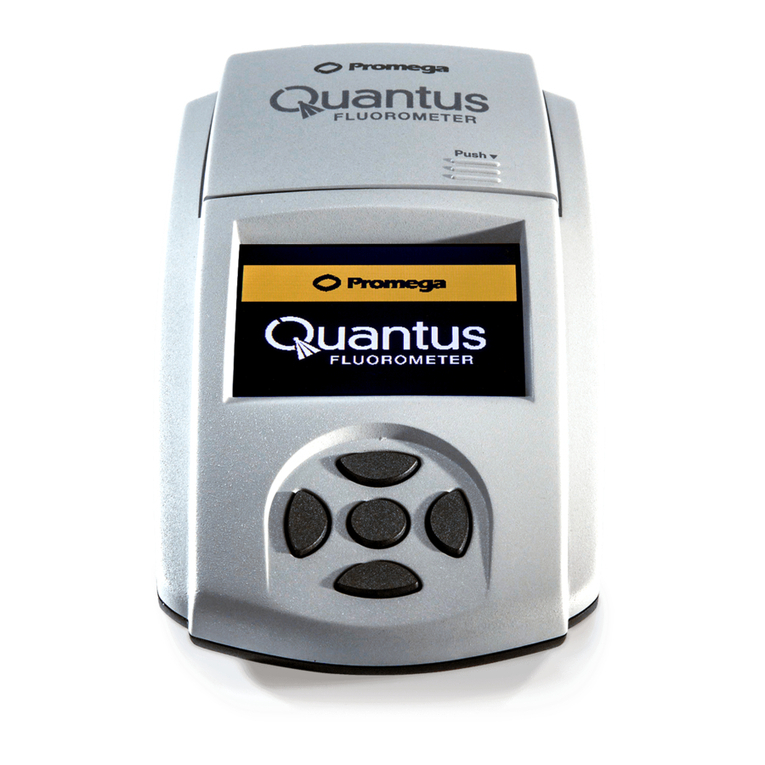
Promega
Promega Quantus Fluorometer User manual
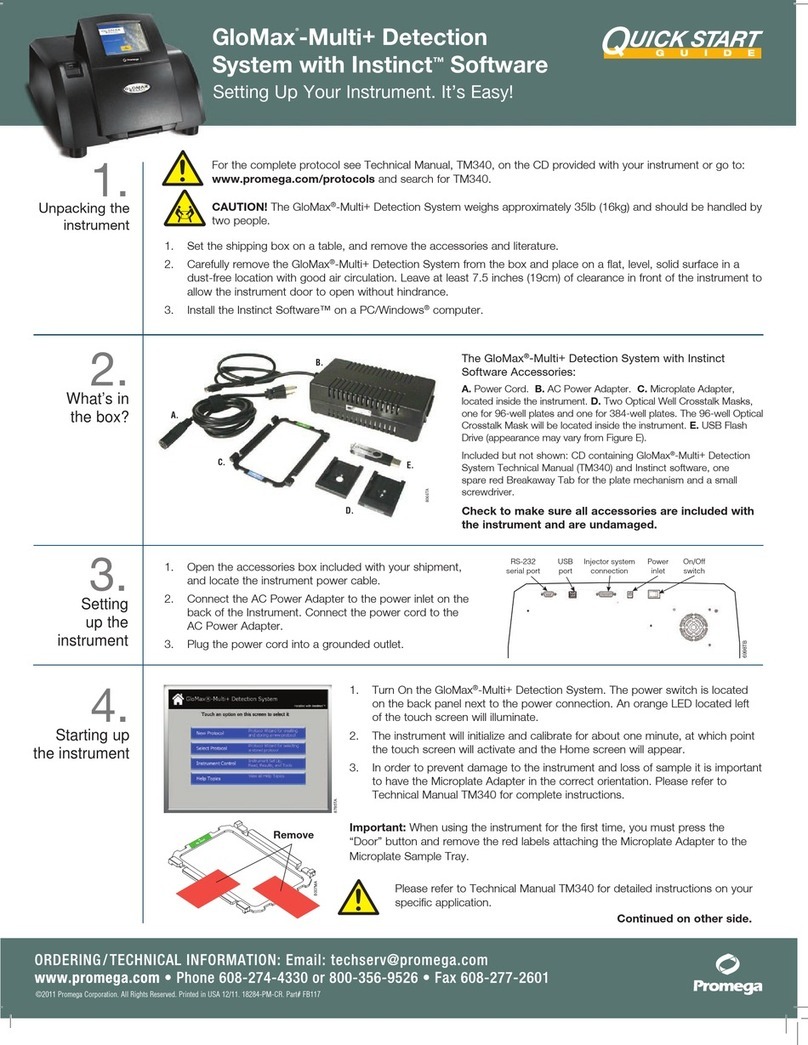
Promega
Promega GloMax-Multi Detection System User manual
